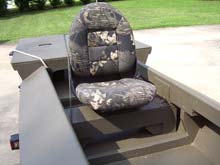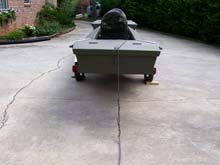I decided to build a river float boat when I reached age 63. It had become very evident that I was just not as nimble as I use to be. My arthritis, bad knees, and weight were preventing me from jumping in and out of my canoe as I once did. I did not want to give up river floating. I have been floating rivers since 1960.
 |
I decided to build a river float boat when I reached age 63. |
I began to research boat plans. I ordered the plans for and built River Runner. I am now 66 years old.
Carroll Hutcheson, my 64 year old river floating buddy, and I have had River Runner on numerous float trips on the Tyger River within the Enoree District of Sumter National Forest located here in South Carolina. We love the adventure and fellowship that river floating offers.
The initial floats led me to make some modifications to River Runner. I cut out the seats, move their locations, and lower them by 2 inches. The springs on the bottom of the seats were also removed. The top of the seats are 14 inches from the bottom. River Runner is now balanced and trimmed for our use.
| The top of the seats are 14 inches from the bottom. River Runner is now balanced and trimmed for our use. |
 |
I shimmed the boat seat pedestal bases 1/2 inch. We always wear a PFD. The seats were not tilled back enough to allow for the PFD to be worn and feel comfortable on a day long river float.
The top inside edges of the cockpit frame were rounded utilizing a hand router. The previous edge had bothered my legs as they lay against the cockpit side.
The cockpit carries an ice chest behind the front seat. The cockpit also carries an extra canoe paddle and a four prong cultivator rake. We use the rake to move debris at logjams plus pull and hold River Runner along side a boat ramp or sandbar in order to load and unload. We also use the rake to move and pull tree limbs to us so we can saw them off with a bow saw.
I built hatches/lids on the front and rear decks. The decks are strong enough for a man to sit or stand on. It had been difficult to store and retrieve equipment from under the fixed front and rear decks.
 |
I built hatches/lids on the front and rear decks. The decks are strong enough for a man to sit or stand on. |
We carry two folding chairs, a come along, and bow saw under the front deck. We store ponchos, first aid kit, extra rope, etc. under the rear deck. The storage area under the lids is also used to store individual coffee and soup thermoses, lunch bags, personal items, etc.
Carroll and I like the decks. Carroll has gotten on the front deck in order to cut our way through the branches of a down tree. I have gotten into shallow water to move small logs and debris. I then sat on the rear of the stern deck and got into the boat.
Carroll and I employ a long forgotten river johnboat navigational aid. The navigational aid is a “Cow Chain” dragging behind River Runner. The drag rope is attached to six feet of iron chain. We have found that a length of seven feet dragging from the end of River Runner works best for us during normal river conditions. We can adjust the length of the rope to match other river conditions.
| Carroll and I employ a long forgotten river johnboat navigational aid. The navigational aid is a “Cow Chain” dragging behind River Runner. |
 |
The “Cow Chain” produces absolutely amazing results. The boat seems to be on automatic pilot. The dragging “Cow Chain” restrains River Runner’s forward movement. The river current passes under the sloped stern. The forward motion of the current is not blocked by a standard style outboard transom. The river current also passes along the sides of the boat and causes the bow to point downstream and follow the main current.
We insure that the weight under the front lid is more than the weight under the rear lid. This weight insures the bow points downstream as we drag our “Cow Chain.”
We can float long periods of time without using our paddles. River Runner will continue downstream in the main current and round bends in the river without any assistance. I cannot express how amazed we have been. I occasionally have to paddle to get around a tree that has fallen into the river. The boat is easy to paddle. The sloped cockpit side allows me to sit in the middle of the boat and paddle. I can paddle, bypass a tree, stop paddling, and the current will quickly return the bow to a position of pointing downstream in the main current.
The motion of canoe paddles flashing in the sun, paddlers moving their arms, etc scares wildlife. We can remain motionless as River Runner self guides us down the river. We are now more likely to slip up on wildlife. The sighting of wildlife is a thrill and makes the trip extremely enjoyable.
We floated the Tyger River during January. I had never floated the river during winter. I did not trust my canoe and myself. River Runner carried us down the river without any fear of “rolling on the river.”
River Runner always lands its aging crew safely. The sloped bottom slides easily onto the landing. The flat bottom prevents the boat from rocking. The deck allows us to sit on it and swing around onto the landing.
 |
The flat bottom prevents the boat from rocking. The deck allows us to sit on it and swing around onto the landing. |
Carroll and I, both 18-year-old adventurers at heart, have ceased using a canoe to drift rivers. River Runner, with our modifications, is now our boat of choice. The aging crew greatly appreciates her stability and “Cow Chain” self-guiding ways. River Runner is going to allow us to float rivers for several more years in safety and comfort.
A WORD OF CAUTION ABOUT BUILDING A RIVER RUNNER AND FLOATING SMALL RIVERS!!! Old men will feel young again, have more fun than the law allows, and develop a treasure chest full of wonderful memories.
If I live to be a very old man, I will have a lot of wild tales to tell.
Let’s see, hum, I believe it was way back in 06, or maybe it was way back in 07, don’t remember things to good these days. Carroll, River Runner, and myself were fighting our way down the Tyger River. There were down trees in the river to the right of us, there were sandbars to the left of us, and shallow water just ahead. We were surrounded by a deep, dark, foreboding forest. Wild animals and birds were calling, a snake dropped off of a tree limb into the water, and vultures were circling overhead anticipating a meal.
We rounded the next bend and before our very eyes appeared the largest river demon we had ever seen. The river demon was waiting for us and lay in the river from bank to bank. River demons taunt river floaters and try to prevent their safe passage downstream. We had to get through to save ourselves.
River Runner eased us beside the demon and we immediately engaged in hand-to-hand combat. Carroll was cutting, slashing, and sawing our way through the river demon’s limbs. It was an awful sight to behold. I was throwing parts of the demon behind River Runner. The demon fought back! A demon arm (limb) sprang forward and struck me in the chest. I was wearing my armor (lifejacket) and the blow was deflected. The demon struck back again and knocked my helmet (river hat) off. That really got PaPa charged up. I then jumped into the shallow water and attacked the demon with my bear hands. I threw small demon logs and limbs to the left of me; I threw demon debris to the right of me. Finally, after what seemed like an eternity of hand to hand combat, we broke free of the river demon.
We quickly accessed our situation. We cleaned all the demon’s remains (debris) out of River Runner. We opened our emergency rations and water. We refreshed ourselves and prepared to continue down river.
We rounded the next bend and Carroll whispered; “Ben, Ben, do you see what I see!!!” Etc, etc, etc, etc.
***** |

